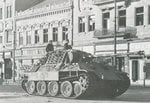B-17engineer
Colonel
Thanks yet again Charles, especially for the 'action' pic and the profile. It brings it all together nicely, and would make a good subject for a model.
Terry.
Agreed Terry, I just have to read this thread start to finish cause I would like to up my knowlegde on tanks. Thanks guys for the information and pictures










